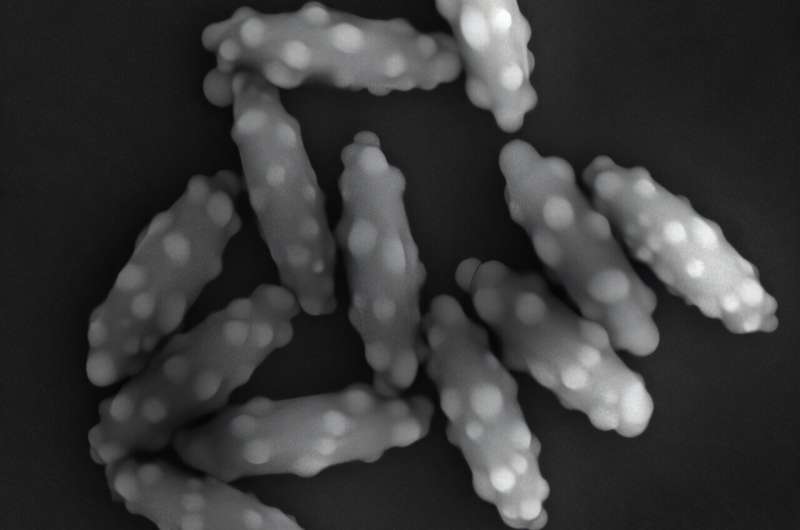The so-called glass transition is the process by which some liquid-like materials become solid-like, without forming a crystalline structure. In contrast to conventional solid materials, which exhibit an orderly atom arrangement, glass is characterized by a disordered atomic structure.
Researchers at Soochow University, Nanyang Technological University and the Beijing Institute of Technology recently carried out a study exploring the effects of surface roughness on the glass transition observed in elongated particles called colloidal ellipsoids. Their paper, published in Physical Review Letters, shows that introducing tiny irregularities on the surface of these particles to increase their roughness can disrupt their transition into glass.
“One of the central debates surrounding the glass transition is the relationship between structure and dynamics in glass-forming liquids,” Dr. Ran Ni, senior author of the paper, told Phys.org. “Previous studies have identified various structural features potentially linked to dynamic heterogeneity, a phenomenon that becomes even more pronounced in the glass transition of anisotropic particles.”
The key objective of the recent study by Dr. Ni and his colleagues was to further explore the well-documented correlation between the structure and dynamics of anisotropic systems (i.e., systems exhibiting properties that vary depending on the orientation in which measurements are collected), particularly monolayer colloidal ellipsoids. The researchers wished to determine whether this correlation remained robust following the introduction of minor modifications to the shape of the particles, which altered their surface roughness.
“Importantly, these modifications do not qualitatively alter the overall structural properties of the system, allowing us to isolate their impact on the dynamics,” said Dr. Ni.
To explore the effects of the modifications they introduced on the formation of glass in colloidal monolayers, the researchers performed both real-world experiments and molecular dynamics simulations. In their experiments, they examined a colloidal system that can be directly visualized using an optical microscope, as this allowed them to analyze individual particles inside it.
“By precisely controlling the morphology of colloidal particles, we systematically examined how subtle variations in shape influence the system’s behavior,” explained Dr. Ni. “Complementing the experiments, we conducted molecular dynamics simulations of anisotropic particles, modeling ellipsoidal particles coated with small spheres to mimic the experimental system. This dual approach allowed us to gain deeper insights into how surface roughness alters the glass transition.”
Dr. Ni and his colleagues found that while the surface roughness of colloidal ellipsoids does not affect their structural features, they can dramatically alter their dynamical properties. In fact, by introducing tiny irregularities on the surface of these particles, the team was able to prevent them from transitioning into the so-called orientational glass, in which the rotation of particles is glassy, while their translational motion remains fluid-like.
“Specifically, we observed that the two-step glass transition characteristic of smooth colloidal ellipsoids disappears when even a slight degree of surface roughness is introduced,” said Dr. Ni. “This result challenges the generality of the structure-dynamics correlation in glass-forming liquids and suggests that surface roughness could serve as a new design parameter for tuning the dynamical and mechanical properties of glassy materials.”
The recent work by this team of researchers advances the physics community’s understanding of the glass transition, while also introducing a promising approach to tune the properties of materials. In the future, it could inform the engineering of materials for a wide range of purposes, ranging from soft robots to consumer products.
“Moving forward, we plan to further investigate how surface roughness influences the dynamic assembly of anisotropic particles,” added Dr. Ni. “Our goal is to establish a general connection between surface roughness and the collective dynamics of rough particles. If successful, this research could open new avenues for designing functional soft materials with tailored mechanical properties, providing an additional degree of control in material engineering.”
More information:
Jian Liang et al, Glass Transition in Monolayers of Rough Colloidal Ellipsoids, Physical Review Letters (2025). DOI: 10.1103/PhysRevLett.134.038202. On arXiv: DOI: 10.48550/arxiv.2407.11479
© 2025 Science X Network
Citation:
Surface roughness disrupts glass transition in colloidal ellipsoids, offering a new material design parameter (2025, February 5)
retrieved 5 February 2025
from https://phys.org/news/2025-02-surface-roughness-disrupts-glass-transition.html
This document is subject to copyright. Apart from any fair dealing for the purpose of private study or research, no
part may be reproduced without the written permission. The content is provided for information purposes only.

